|
Good to the Last Drop
by Bob Brooke
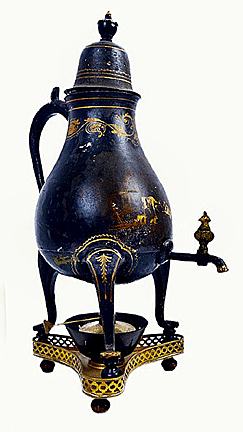 Coffee
has been energizing people since dawn of the first millenium of the
Christian Era (CE) when they first roasted and ground Arabica beans.
Historians believe that an Arabic word, qah’wa, inspired the term
“coffee,” a wine made from coffee beans. When people first began
drinking coffee, they had to first soften the beans for roasting, boil a
kettle full of water for about a minute with the coarse ground coffee
beans. Coffee
has been energizing people since dawn of the first millenium of the
Christian Era (CE) when they first roasted and ground Arabica beans.
Historians believe that an Arabic word, qah’wa, inspired the term
“coffee,” a wine made from coffee beans. When people first began
drinking coffee, they had to first soften the beans for roasting, boil a
kettle full of water for about a minute with the coarse ground coffee
beans.
For centuries, coffee grew in ancient forests on Ethiopia’s plateau.
According to legend, a goat herder named Kaldi first discovered the
beans’ potential there. The Turks first began brewing coffee in 575 CE
in hot water in an ibriq, a
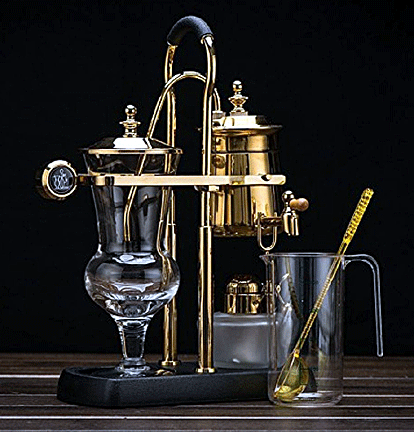 high
and narrow copper poacher with a long handle. From then on, people
brewed coffee in a variety of vessels.. high
and narrow copper poacher with a long handle. From then on, people
brewed coffee in a variety of vessels..
One of the most unusual was the balance siphon, which looked a lot like
a scale. As the water infused from one side of the mechanism to the
other, a snuffer would cover the flame, turning off the heat, allowing
the water to cool and return to the original chamber.
Early Coffee Pots
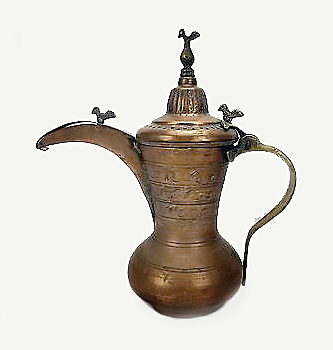 The
earliest known coffee pot, a primitive version of the French press, was
invented in the 15th century in Arabia. People used this pot, made of a
heavy metal and had a long spout, to make a strong, thick brew which
they served in small cups. In the 17th century, someone added a lid to
keep the heat in, and in the 18th century, someone else added a handle
for easier pouring. The
earliest known coffee pot, a primitive version of the French press, was
invented in the 15th century in Arabia. People used this pot, made of a
heavy metal and had a long spout, to make a strong, thick brew which
they served in small cups. In the 17th century, someone added a lid to
keep the heat in, and in the 18th century, someone else added a handle
for easier pouring.
The first coffee pot was made in the 17th century in France, although
coffee had been around for centuries prior to this. The pot was made of
brass and was heated by a flame. Over time, these pots were made from
other materials such as silver and porcelain.
In 1672, an Armenian named Pascal used a silver coffee pot to brew
coffee in a tent at the St. Germain Spring Fair in Paris. To increase
sales, Pascal sent out his Turkish waiter boys throughout the streets of
Paris, merrily yelling “Café! Café!” With pitcher and cups in hand, they
poured and sold the steaming beverage door-to-door.
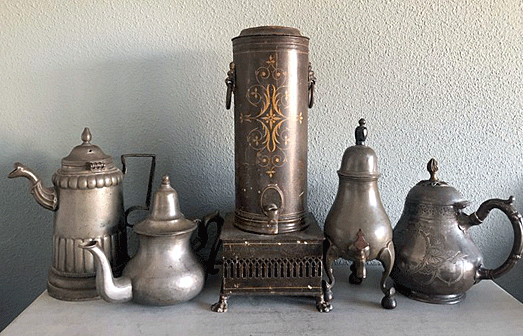
Soon English and American silversmiths began to create some beautiful
forms for coffee pots. As the 18th century dawned, the consumption of
coffee resulted in the mass manufacture of coffee pots. There are some
magnificent examples from this period: from plain cylindrical forms to
pear shaped deeply fluted bodies and elegant flat chased ornamentation.
Form Follow Function
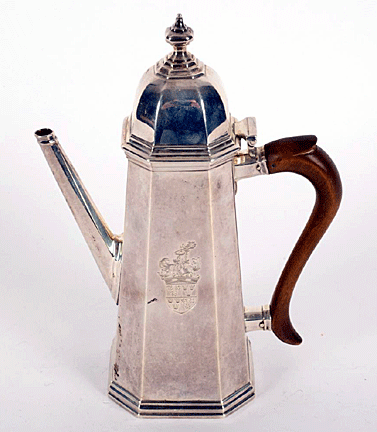 Soon
after this, coffee pots began to be crafted in a tapered cylinder shape
with a high domed cover. Makers placed the spout low on the body, along
with the classic right-angled handle. Octagonal designs appeared around
1710. This style encompassed a flatter wider base, along with a top in
the tear-shaped drop form. Soon
after this, coffee pots began to be crafted in a tapered cylinder shape
with a high domed cover. Makers placed the spout low on the body, along
with the classic right-angled handle. Octagonal designs appeared around
1710. This style encompassed a flatter wider base, along with a top in
the tear-shaped drop form.
At the same time, coffee brewing took a step ahead as the popularity and
demand for coffee grew, so did the need for specialized vessels
specially designed for the brewing of coffee, featuring an attached lid
to help the infusion process. The pots also had a
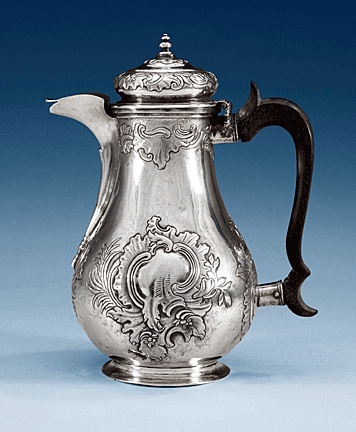 tapered
cylinder shape with a high domed cover. The bottom of the pots became
wider than the top, with spouts relocated to the side, in order to help
catch the sinking coffee grounds. Another reason for the necessity of
coffee pots was so that coffee could be consumed at home. tapered
cylinder shape with a high domed cover. The bottom of the pots became
wider than the top, with spouts relocated to the side, in order to help
catch the sinking coffee grounds. Another reason for the necessity of
coffee pots was so that coffee could be consumed at home.
Coffee pot makers didn’t place the spout on the opposite side of the
handle on pots until the 1720s. The incurved base of the coffee pot
became standard in the 1730s along with the plain tapered form. The
pear-shaped coffee pot came into fashion around the 1740s and prevailed
until the 1760s. These jugs tended to have shorter spouts.
Coffee Pot Styles Change Again
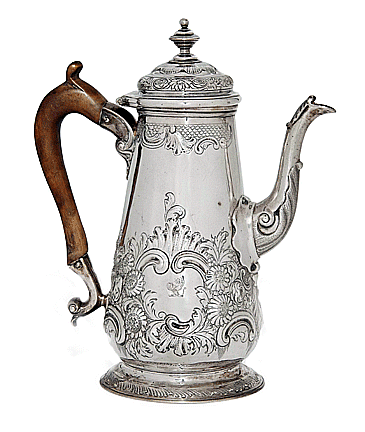 During
the Rococo or late Baroque Era, the style of coffee pots changed again,
becoming larger and more impressive, in a more ornate style. Festoons
became a prominent ornament. During
the Rococo or late Baroque Era, the style of coffee pots changed again,
becoming larger and more impressive, in a more ornate style. Festoons
became a prominent ornament.
By the 1780s, people began adding filters to coffee pots in the form of
a cloth or sock placed over the mouth. They placed ground coffee in the
sock, then poured hot water over them.
In the late 18th Century some beautiful examples were crafted by the
likes of Paul De Lamerie; they featured classic rococo ornamentation
which consisted of flowing, asymmetric details and natural
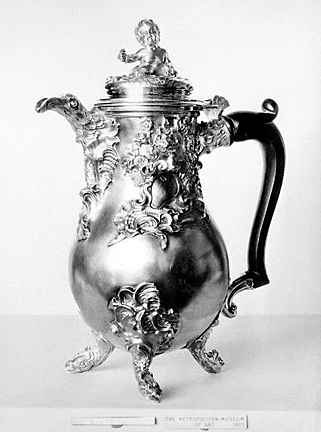 motifs
including shells (which would often be the chosen shape for a finial).
This renowned London silversmith was well known for his craftsmanship in
producing fine and collectable coffee pots. motifs
including shells (which would often be the chosen shape for a finial).
This renowned London silversmith was well known for his craftsmanship in
producing fine and collectable coffee pots.
Pear-shaped coffee pots made their way into fashion around the turn of
the century, but they didn’t last long. During the Rococo era, coffee
pot style once again evolved. Paul DeLaMotte created some truly
beautiful examples during the late 18th century. In the 1780s, people
used a sock to form a coffee filter, into which they placed the ground
coffee, through which they then poured hot water. But the practice was
expensive because the cloth filters were so inefficient.
The Introduction of the Drip Pot
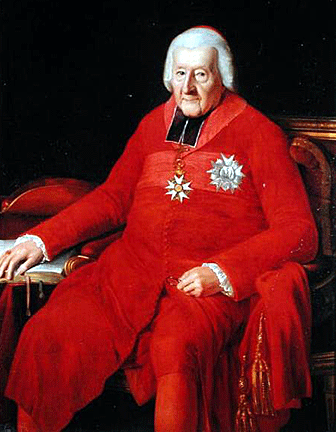 Jean
Baptiste de Belloy, the Archbishop of Paris invented the first drip
coffee pot in 1800. Made of tin, porcelain, and silver, it lasted for
several years. His revolutionary device had two parts: an upper
container that held ground coffee and an empty lower container that had
a cloth filter between it and the top. In this simple yet effective
setup, he revolutionized the way people brewed coffee. Jean
Baptiste de Belloy, the Archbishop of Paris invented the first drip
coffee pot in 1800. Made of tin, porcelain, and silver, it lasted for
several years. His revolutionary device had two parts: an upper
container that held ground coffee and an empty lower container that had
a cloth filter between it and the top. In this simple yet effective
setup, he revolutionized the way people brewed coffee.
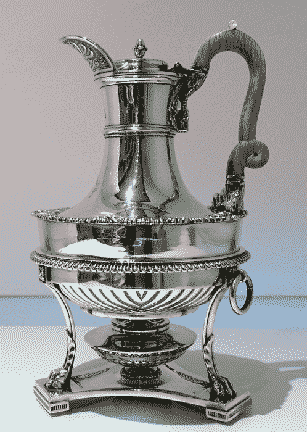 Mr.
Biggin Coffee Pots was the first company to introduce a coffee pot,
called the Mr. Biggin, with a place for the filter and these pots
received instant popularity. Unfortunately, the taste of the cloth
filter often became undesirably transferred to the coffee, itself.
Historians regard the Mr. Biggin as the world’s first commercial coffee
maker that came into common use in England around 1817. It was usually
an earthenware pot. At first it had in its upper part a metal strainer
like the French drip pots. Later models had a flannel or muslin bag Mr.
Biggin Coffee Pots was the first company to introduce a coffee pot,
called the Mr. Biggin, with a place for the filter and these pots
received instant popularity. Unfortunately, the taste of the cloth
filter often became undesirably transferred to the coffee, itself.
Historians regard the Mr. Biggin as the world’s first commercial coffee
maker that came into common use in England around 1817. It was usually
an earthenware pot. At first it had in its upper part a metal strainer
like the French drip pots. Later models had a flannel or muslin bag
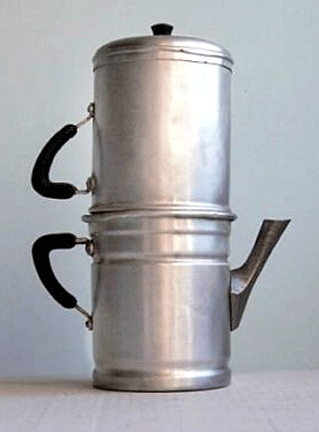 suspended
from the rim to hold the ground coffee through which the user poured
boiling water. This acted as a filter. People called any coffee pot with
such a bag fitted into its mouth a coffee biggin. Even later, the coffee
biggin evolved into a metal pot with a wire strainer substituted for the
cloth bag. suspended
from the rim to hold the ground coffee through which the user poured
boiling water. This acted as a filter. People called any coffee pot with
such a bag fitted into its mouth a coffee biggin. Even later, the coffee
biggin evolved into a metal pot with a wire strainer substituted for the
cloth bag.
The cuccuma—also known as the cuccumela or the Neapolitan flip coffee
pot—used a traditional Italian coffee brewing method. It has long been a
staple for many Italian home coffee brewers. The cuccuma was a
reinvention of the stovetop pot created during the early 19th century in
France by Archbishop Jean Baptiste de Belloy. It was first made of tin;
but later, of porcelain and silvert.
Percolators Come on the Scene
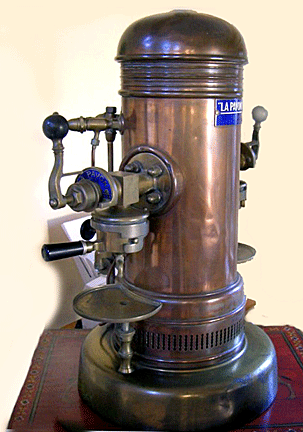 By
1818, espresso machines and coffee percolators had been introduced. In
1822, Louis Bernard Rabaut developed a brewing machine that used steam
to force hot water through the coffee grounds, creating the first early
version of espresso. But it was By
1818, espresso machines and coffee percolators had been introduced. In
1822, Louis Bernard Rabaut developed a brewing machine that used steam
to force hot water through the coffee grounds, creating the first early
version of espresso. But it was
Italian Luigi Bezzera who patented the first commercial “espresso”
machine—the Tipo Gigante—a large steam driven machine that used a water
and steam combination, forced under high pressure to brew the coffee
rapidly. It was his invention that became known as the “espresso”
machine.
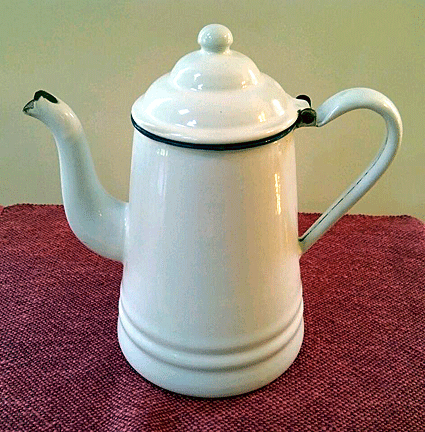 Prior
to the beginning of the 20th century, the enamelware, aluminum, or tin
pot used for boiling water and brewing coffee in many working class
homes was usually one and the same. After setting the pot on a stove and
bringing the Prior
to the beginning of the 20th century, the enamelware, aluminum, or tin
pot used for boiling water and brewing coffee in many working class
homes was usually one and the same. After setting the pot on a stove and
bringing the
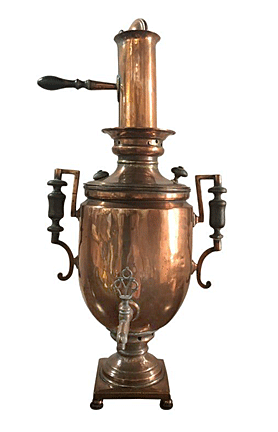 water
inside it to a boil, ground coffee would simply be measured into the
pot, where the grounds would swell and mostly sink to the bottom,
producing a gritty, unfiltered brew. water
inside it to a boil, ground coffee would simply be measured into the
pot, where the grounds would swell and mostly sink to the bottom,
producing a gritty, unfiltered brew.
The late 19th century witnessed the invention of the percolator which
solved the problem of gritty coffee. Designers created the first ones
for stove tops. The percolator’s chief advantage was that it had a
filter to separate the brewed coffee from the soggy grounds. While
manufacturers made most early stovetop percolators out of aluminum and
other inexpensive metals, they produced some of copper.
Amalia Melitta Bentz, a housewife from Dresden, Germany, invented the
first drip coffee maker in 1908. She discovered that percolators tended
to over-brewi the coffee, espresso-type machines tended to leave grounds
in the drink, and linen bag filters were exhausting to clean. She
experimented with many means but made a two-part filtration system using
blotting paper from her son Willy's school exercise book and a brass pot
punctured using a nail. The result was a cheap, disposable, and
easy-to-clean coffee filter that produced tastier coffee.
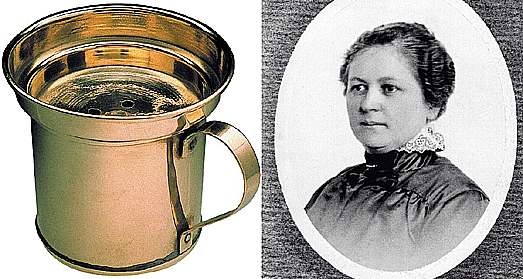
Espresso Pots
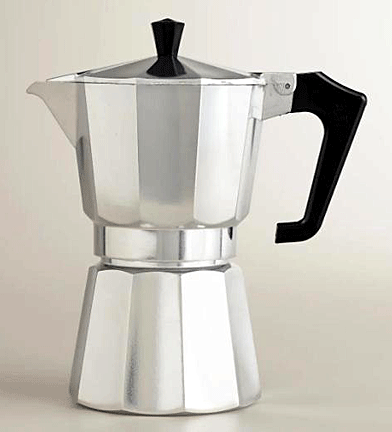 The
moka pot was a stove-top variation of the percolator that brewed coffee
by passing boiling water pressurized by steam through ground coffee
first and then into a separate holding tank. Named after the Yemeni city
of Mocha, it was invented by Alfonso Bialetti in 1933. It quickly became
one of the staples of Italian culture. Moka pots were typically made of
aluminum, but stainless steel or other alloys could also have been used.
Some designs feature an upper half made of heat-resistant glass. Instead
of forcing water up through a tube and then over the grounds as in a
percolator, a moka pot forced water through the grounds first and then
into a separate holding tank. The
moka pot was a stove-top variation of the percolator that brewed coffee
by passing boiling water pressurized by steam through ground coffee
first and then into a separate holding tank. Named after the Yemeni city
of Mocha, it was invented by Alfonso Bialetti in 1933. It quickly became
one of the staples of Italian culture. Moka pots were typically made of
aluminum, but stainless steel or other alloys could also have been used.
Some designs feature an upper half made of heat-resistant glass. Instead
of forcing water up through a tube and then over the grounds as in a
percolator, a moka pot forced water through the grounds first and then
into a separate holding tank.
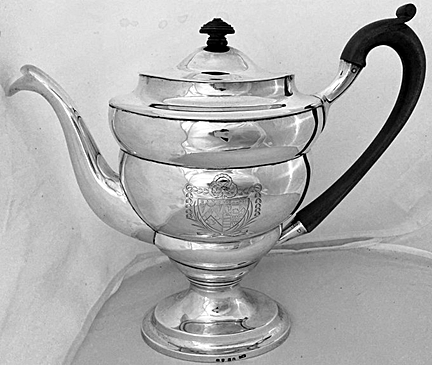 In
Turin, in 1933, Alfonso Bialetti invented the first moka pot by
observing the lisciveuse, a steam pot utilized at that time for laundry.
In 1946 his son Renato started industrial production, selling millions
of moka pots in one year, versus only 70000 sold by his father in the
previous 10, making the coffee maker (as well as coffee) an icon of
Italy in the world. Naples, albeit being known today as the city of
coffee, has seen it later, probably through the ships coming in the
ports of Sicily and Naples itself. In
Turin, in 1933, Alfonso Bialetti invented the first moka pot by
observing the lisciveuse, a steam pot utilized at that time for laundry.
In 1946 his son Renato started industrial production, selling millions
of moka pots in one year, versus only 70000 sold by his father in the
previous 10, making the coffee maker (as well as coffee) an icon of
Italy in the world. Naples, albeit being known today as the city of
coffee, has seen it later, probably through the ships coming in the
ports of Sicily and Naples itself.
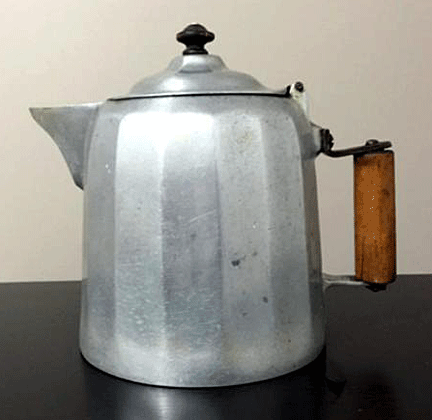 People
used many coffee pots just for serving, in the same way that they used
teapots. Some early 20th-century coffee pots had a thermos built right
into the pot. Others, like the Fiesta ware pots from the late 1930s
through the early 1940s kept coffee warm only as long as the insulating
properties of ceramics would permit. People
used many coffee pots just for serving, in the same way that they used
teapots. Some early 20th-century coffee pots had a thermos built right
into the pot. Others, like the Fiesta ware pots from the late 1930s
through the early 1940s kept coffee warm only as long as the insulating
properties of ceramics would permit.
Other coffee pots, such as those made by Wagner Ware and Chemex utilized
the Biggin method of brewing coffee, essentially the drip method most
current electric coffee makers use today. Wagner pots from the 1930s
were of brushed aluminum, with aluminum filters and Bakelite handles.
Chemex pots, invented in the 1940s, had a single, hourglass-shaped piece
of crystal-clear blown glass and featured a wooden handle around the
pot’s waist and a round filter that fit perfectly into the top part of
the hourglass when folded in quarters.
<
Back to Antiques Archives
Next Article > |
